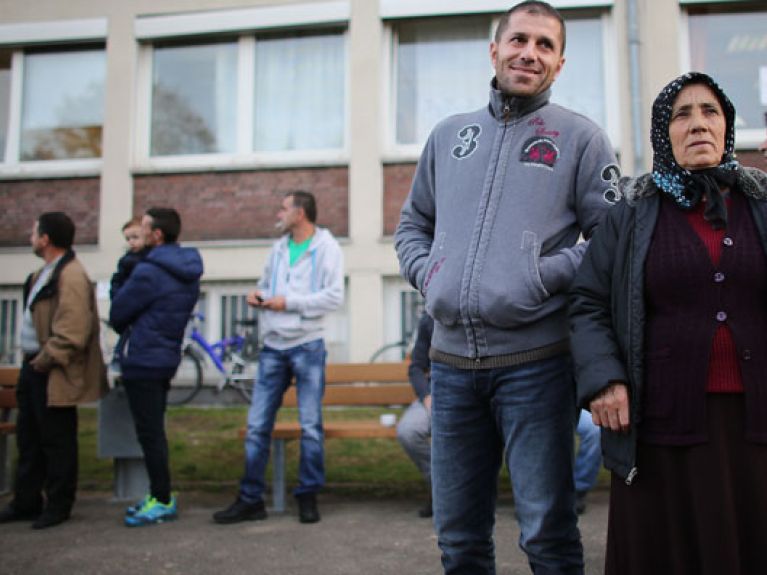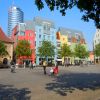The big challenge for Germany’s cities
Cities are doing all they can to look after asylum seekers. But some are reaching their limits.

Helpers have stretched plastic tarpaulins between the beds which crackle slightly when touched. Some have things like towels, children’s trousers or a down jacket hanging on them. A young man with black hair and glasses pushes the tarpaulin to one side and peers out, a friendly look on his face. “Hello, how are you?” A basketball net is suspended from the ceiling – this brick building in Bergisch Gladbach’s Sand district is a gymnasium. Since July 2015, it has provided rudimentary accommodation – for 78 people at first, and now for 93. They are refugees from Syria and Afghanistan; everything they own fits into a small suitcase under the bed.
Local women have set out coloured paper, scissors and crayons in the entrance hall. They are making things with the refugee children to take their minds off what they experienced on their long journeys. Some of the older children have also joined in and are drawing pictures, simply to have something to do. When asked how long they will be staying in Sand, they shrug their shoulders. They do not know. They will remain at the initial reception centre in Sand for a few weeks or months and then move into smaller facilities. The gymnasium merely provides provisional accommodation. Lutz Urbach, the mayor of Bergisch Gladbach, looks serious and thoughtful these days. Normally he is a man who throws himself into his job with great optimism and verve, who likes to chat about football and is always happy to roll up his shirt sleeves and get stuck in. The question of how to deal with the refugees in this city of 110,000 inhabitants is weighing him down. As many as 2,000 refugees could arrive by the end of 2015. Yet Urbach was one of those who had already warned back in the summer that there were not the facilities to take infinite numbers. Nonetheless, the influx showed no signs of abating.
More than 800,000 people have fled to Germany since the beginning of 2015. It is the job of local governments to receive and provide for them. Although Bergisch Gladbach’s 2016 budget is already hard hit, showing an 18.5 million euro deficit, local people are giving the refugees a warm welcome all the same. The new arrivals are being looked after by city employees, aid organisations and a tight network of volunteers. The German Red Cross alone recruited 144 additional staff in the Rheinisch-Bergische district in the space of four weeks and is running various facilities to accommodate the refugees.
Mayor Lutz Urbach, a proactive type with grey-flecked hair and bright, alert eyes, says: “Our city is rich because we have people like them.” Bergisch Gladbach bought up a hotel and a building that had formerly housed a publishing company, and believed it would be able to cope with the refugee situation. By mid-2015, the city had already put together a refugee task force at the town hall so that accommodation could be acquired flexibly and quickly. Yet far more refugees than anticipated have been flocking to the city for months. It pains those in charge to have nowhere better to put them up than in simple lightweight structures and sports facilities. In October 2015, Lutz Urbach joined more than 200 other mayors in the state of North Rhine-Westphalia in signing a letter to Federal Chancellor Angela Merkel, writing that virtually all the available accommodation options were now exhausted. In addition, they explained that so many personnel were needed to deal with the housing of refugees “that we are unable to perform our other duties, or can only do so to a limited extent.”
Ulrich Maly is only too familiar with the challenges facing cities and local authorities. He is the vice president of the Association of German Cities and the mayor of Nuremberg. As Maly explains, refugees in Germany are currently housed in gymnasiums, tents, river boats, hotels and former furniture stores. “There is no option that isn’t being exploited.” He goes on to say that providing them with initial makeshift accommodation is merely the tip of the iceberg. The next big challenge involves their long-term integration. School and nursery places, housing and jobs are needed, as are integration courses and German classes. Maly says: “We can achieve this, but not on a zero budget.” The Association of German Cities is calling for more support from the federal and state governments. It represents 3,400 cities and communities with 51 million inhabitants in Germany. The flow of migrants seen in 2015 can be coped with, says Maly, “but I do not think it would be possible to handle migration on this scale if it were to continue for ten years.” He continues to explain that almost every municipality has one area in which it is no longer able to meet its standards – but can do nothing about it.
Many of the refugees arriving in Bergisch Gladbach entered Germany via Passau. This city on the border to Austria and the Czech Republic has become a hub for refugees – at times conditions there are chaotic, with up to 20,000 new arrivals every week. The city has now settled into a routine: refugees are first registered at three reception “hotspots”, explains the city’s mayor, Jürgen Dupper. The morning after their arrival, special trains and buses are laid on to transport them to the rest of the country – including to Bergisch Gladbach, 600 kilometres away. It is usually dark by the time they arrive there. A tent has been set up in the courtyard of the Red Cross centre – brightly lit, it is warm inside and helpers have prepared soup. “They arrive and get something to eat and drink. That is the most important thing at first,” says Reinhold Feistl. “The refugees are exhausted.” As the director of Rheinisch-Bergische district’s branch of the Red Cross, Feistl oversees the coordination of the Red Cross refugee aid activities in the south of North Rhine-Westphalia, the staff and the administration, and is something like the organisation’s heart and soul. “My staff are required to laugh once a day – it’s in their contracts,” says Feistl. When the work gets too frantic, he puts on a clown’s nose during the morning meeting. “We do what we can,” explains Feistl. “We battle. We improvise. Winter is coming.“
“We can do it,” declared Federal Chancellor Angela Merkel in September 2015. Her words were meant to encourage Germany – its people, its cities, its municipalities. “We can’t do it,” countered Tübingen’s mayor Boris Palmer, responding on his Facebook page. He expressed the fears of many ordinary Germans and local communities. A politician in the Alliance 90/The Green Party, Palmer calculated that if 10,000 refugees came every day, Germany would see 3.65 million people arrive in one year. He demands that the influx be restricted, claiming that municipalities are overburdened and that he is concerned about the impact on social peace in Germany. He threatens if necessary to occupy buildings. “I am getting a lot of support at the grassroots level,” says Palmer. “In cities, on the streets, more than ever before.“
To gain an impression of the challenges faced by local governments, Federal President Joachim Gauck visited Bergisch Gladbach in November 2015. “We can do it,” says Mayor Lutz Urbach. Then he added another couple of words. “We can do it – for now.” ▪

